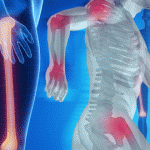Ultrasound’s Advantages
“One of the advantages of ultrasound is that you can characterize tendon, muscle and cortical bone abnormalities. We can see, better than with MRI, any calcifications of gluteal tendons, see excess fluid in the bursa, and assess, through sonopalpation, tenderness. We can do guided injection. And there is low cost, and it is available in many rheumatology departments,” Dr. Möller said. Ultrasound shows moderate sensitivity in prediction of surgically confirmed gluteus medius tears.21 “The limitations of ultrasound to detect tendon changes is mostly seen in obese patients.”
In the lower back, the gluteus maximus and contralateral latissimus dorsi are functionally coupled, assisting with trunk rotation, and stabilizing the lower lumbar spine and SI joints.22 Dr. Möller asked everyone to stand up and rotate their trunks, “and you will feel how your muscles are linked. This is the synergistic action of all these different muscles.” The gluteus maximus exerts compressive force at the SI joints by assisting load transfer between the lower extremities and the trunk, she said.23
“If you look at the upper, mostly abductor part of the gluteus maximus, you can see the insertion in the thoracolumbar fascia,” said Dr. Möller. “I’m a fan of the fascia. I can recognize their value. The thoracolumbar fascia is the most pain-sensitive deep tissue we have in the lower back.”24 The lower gluteus maximus is an extensor, and originates from the sacrum and sacrotuberous ligament. “We have two hip extensor mechanisms, one for speed and the other for power. The hamstrings provide rapid hip extension, whereas the gluteus maximus provides a powerful hip extension.”
Injury to the inferior gluteal nerve in this anatomical region causes difficulty in climbing stairs, standing up from a chair or walking. However, the hamstrings compensate in the standing position.
“This also helps us explain the extraspinal etiology of sciatic pain, or pain from the huge sciatic nerve, which will be aggravated by sitting, and you will have a tender point immediately lateral to the right ischial tuberosity,” said Dr. Möller.25 The deep, very powerful gluteus medius balances the side-to-side movement of the trunk during bipedal gait, and this muscle is a hip stabilizer and pelvic rotator.26 Every portion of the muscle contracts in a different way through each phase of gait.
“The superior gluteal nerve that innervates the gluteus medius is one nerve with three different branches for the three different portions of the muscle. That means you can damage one portion and you lose one of the activities during gait,” she said. “The posterior fibers of the gluteus medius are stabilizers, because they bring the femoral head closer to the acetabulum. The middle fibers, which are parallel to the axis of the femur, provide an important contribution in an extended posture, because abduction contributes to lateral stability during locomotion. The anterior fibers perform a function during internal rotation. The gluteus medius, this huge muscle, is powerful, and must perform the force of twice the body weight during a monopodial stance at the normal gait.”27 Fatty degeneration of the gluteus medius plays a role in loss of stability in the pelvis and may increase risk of falls.28 If a patient has a gluteus medius tear on one side, the contralateral side will drop when they put their weight on the affected hip when standing, she said.
Ultrasound can show hip abductor tears and pathological changes in the hip, such as calcifications, loss of fibrillar pattern, changes in tendon morphology, bone irregularities, and even the absence, or full tear, of the trochanteric tendon, said Dr. Möller. Conservative treatment of chronic hip abductor tear includes non-steroidal anti-inflammatory drugs (NSAIDs), exercises and local injections, but patients with persistent pain and functional limitation may need surgery.29

